Rias Body was born the slave property of Mr. Ben Body, a Harris County planter. He states that he was about fifteen years old when the Civil War started and, many years ago, his old time white folks told him that April 9, 1846, was the date of his birth.
The “patarolers,” according to “Uncle” Rias, were always quite active in ante-bellum days. The regular patrol consisted of six men who rode nightly, different planters and overseers taking turns about to do patrol duty in each militia district in the County.
All slaves were required to procure passes from their owners or their plantation overseers before they could go visiting or leave their home premises. If the “patarolers” caught a “Nigger” without a pass, they whipped him and sent him home. Sometimes, however, if the “Nigger” didn’t run and told a straight story, he was let off with a lecture and a warning. Slave children, though early taught to make themselves useful, had lots of time for playing and frolicking with the white children.
Rias was a great hand to go seining with a certain clique of white boys, who always gave him a generous or better than equal share of the fish caught.
At Christmas, every slave on the Body plantation received a present. The Negro children received candy, raisins and “nigger-toes”, balls, marbles, etc.
As for food, the slaves had, with the exception of “fancy trimmins”, about the same food that the whites ate. No darky in Harris County that he ever heard of ever went hungry or suffered for clothes until after freedom.
Every Saturday was a wash day. The clothes and bed linen of all Whites and Blacks went into wash every Saturday. And “Niggers”, whether they liked it or not, had to “scrub” themselves every Saturday night.
The usual laundry and toilet soap was a homemade lye product, some of it a soft-solid, and some as liquid as water. The latter was stored in jugs and demijohns. Either would “fetch the dirt, or take the hide off”; in short, when applied “with rag and water, something had to come”.
Many of the Body slaves had wives and husbands living on other plantations and belonging to other planters. As a courtesy to the principals of such matrimonial alliances, their owners furnished the men passes permitting them to visit their wives once or twice a week. Children born to such unions were the property of the wife’s owner; the father’s owner had no claim to them whatsoever.
“Uncle” Rias used to frequently come to Columbus with his master before the war, where he often saw “Niggers oxioned off” at the old slave mart which was located at what is now 1225 Broadway. Negroes to be offered for sale were driven to Columbus in droves—like cattle—by “Nawthon speckulatahs”. And prospective buyers would visit the “block” accompanied by doctors, who would feel of, thump, and examine the “Nigger” to see if sound. A young or middle-aged Negro man, specially or even well trained in some trade or out-of-the-ordinary line of work, often sold for from $2000.00 to $4000.00 in gold. Women and “runty Nigger men” commanded a price of from $600.00 up, each. A good “breedin oman”, though, says “Uncle” Rias, would sometimes sell for as high as $1200.00.




